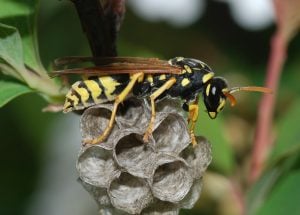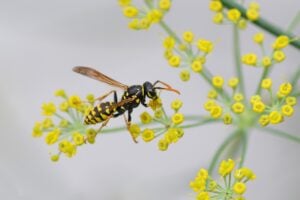Dealing with Wasp Nests this Summer
As we bask in summer’s glow, we might also hear the incessant buzzing coming from flying insects, most notably wasps. These stinging insects can become a real nuisance when their nests get larger and larger. The good news is that it’s not always necessary to remove wasp nests around your home. As these summer months run their course, wasp nests will eventually be abandoned. As autumn approaches, the queen stops laying eggs and the colony begins to die off. Worker wasps, no longer having larvae to feed, become aimless and more prone to scavenging, increasing their interactions with humans.
Of course, until fall arrives, if the nests appear quite often and in areas that could lead to access into your home, then it’s time to have a professional remove the nest. Do not attempt to remove it yourself! Some common places where wasp nests might be in your home include sheltered areas (gutters, roof spaces, etc.) where you will see numerous wasps flying around. Also be on the lookout for their flight paths. This means wall cavities, eaves, sheds, and garages.

Here are some common types of Wasp Nests:
Paper Wasp Nest
Paper wasp nests are commonly constructed under eaves, ledges, door frames, and windows. These nests feature open combs with cells for raising brood and are attached to branches or structures by a narrow stalk. Made from wood fibers collected from plants and chewed into a paper-like material, the hexagonal cells form a nest resembling an upside-down umbrella. Paper wasps also produce a chemical to repel ants, which they apply around the nest’s base to protect their eggs and brood. Typically, these nests are small, housing up to a dozen worker wasps, but can accommodate up to 60 wasps in total.
Mud Daubers Wasp Nest
Mud Dauber wasps construct elongated, finger-like nests from mud, which they adeptly attach to flat or vertical surfaces. The wasps use their mandibles to carefully mold the mud into individual cells. These nests are typically found in sheds, barns, and other structures. Additionally, Mud Daubers often select locations that provide protection from the elements and predators, ensuring the safety and stability of their intricately crafted homes. These nests can be recognized by their unique shape formed by the meticulous craftsmanship of the wasps.
Potter Wasp Nest
Potter wasps are small, solitary insects recognized for their distinctive nests. These wasps, typically black with yellow markings, have a slender “waist” and wings that fold lengthwise. They measure between 3/8 and 3/4 inches in length. Their nests, crafted from a blend of mud and saliva, resemble tiny pots or jugs and serve as shelters for their young.

In late summer and early autumn, wasps become more aggressive. This can be due to them becoming very territorial over their nests, as well as food scarcity.
Despite their bad reputation, wasps are beneficial insects. They help control pest populations by preying on other insects, and many species are also important pollinators. Recognizing their ecological contributions can foster a greater appreciation and a more tolerant attitude towards these often-maligned creatures.
Wasp season, while challenging, is a natural part of the yearly cycle. By understanding wasp behavior and taking proactive steps to manage interactions, we can reduce conflicts and appreciate the important role these insects play in our ecosystem. Keep enjoying the summer sun and try to avoid wasp nests. Just because they are beneficial when it comes to pollinating plants and flowers, doesn’t mean you are safe from painful stings.